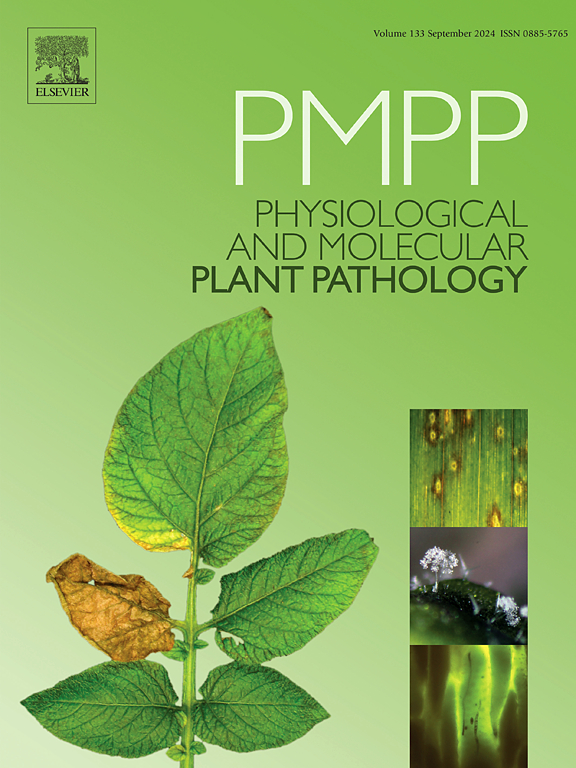Topical application of conserved dsRNA confers sustainable broad-spectrum resistance against leaf curl disease causing begomoviruses in crops
IF 2.8
3区 农林科学
Q2 PLANT SCIENCES
引用次数: 0
Abstract
Leaf curl disease caused by begomoviruses is a significant global threat to economically important crops. RNA interference (RNAi), activated by double-stranded RNA (dsRNA) has been proved as an effective strategy to control plant viruses. This study proposes a novel RNAi-mediated approach to combat a broad spectrum of begomoviruses. The conserved regions identified from various DNA-A components of begomoviruses were targeted to design the dsRNA molecules in silico. Further, these putative dsRNAs were synthesized in vitro from the hybrid regions of the AV1/AV2 and AC1/AC4 genes of the papaya leaf curl virus (PaLCuV). A single topical application of these dsRNAs conferred broad spectrum resistance against both PaLCuV (a monopartite begomovirus) and tomato leaf curl Palampur virus (ToLCPalV, a bipartite begomovirus). Semi-quantitative PCR revealed a negligible presence of the virus in dsRNA-treated plants compared to untreated controls. Real-time PCR analysis at 15 days post-inoculation (dpi) showed a significant reduction in virus load and an alleviated expression of AV1, AV2, AC1, and AC4 gene transcripts by approximately 9.6, ∼6.1, ∼4.5, and ∼9.3 fold, respectively, against ToLCPalV in Nicotiana benthamiana. Similarly, in papaya plants dsRNA application reduced virus gene expression by ∼6.0, ∼7.7, ∼6.1, and ∼7.7 fold for AV1, AV2, AC1 and AC4, respectively, compared to untreated controls. These results suggested that the antiviral immunity induced by dsRNA was sustained in plants over time. The study highlights the potential of dsRNA molecules synthesized from conserved regions of begomovirus genome, to confer resistance against leaf curl disease. This is the first report to demonstrate that topical application of dsRNA, can induce broad-spectrum resistance in plants against leaf curl disease-causing begomoviruses, offering a promising tool for managing virus diseases in crops.

局部应用保守的dsRNA可获得对作物叶片卷曲病引起的begomovirus的持续广谱抗性
由begomovirus引起的卷叶病是对重要经济作物的重大全球性威胁。由双链RNA (dsRNA)激活的RNA干扰(RNAi)已被证明是控制植物病毒的有效策略。本研究提出了一种新的rnai介导的方法来对抗广谱的begomovirus。针对从begomovirus的各种DNA-A组分中鉴定出的保守区域,在计算机上设计dsRNA分子。此外,从番木瓜卷叶病毒(PaLCuV)的AV1/AV2和AC1/AC4基因的杂交区体外合成了这些推测的dsRNAs。这些dsrna的单次局部应用赋予了对PaLCuV(一种单侧begomomvirus)和番茄卷叶Palampur病毒(ToLCPalV,一种双侧begomomvirus)的广谱抗性。半定量PCR显示,与未处理的对照相比,dsrna处理的植物中病毒的存在可以忽略不计。接种后15天(dpi)的实时PCR分析显示,对本烟中ToLCPalV,病毒载量显著降低,AV1、AV2、AC1和AC4基因转录物的表达分别降低了约9.6倍、约6.1倍、约4.5倍和约9.3倍。同样,在木瓜植物中,与未处理的对照相比,dsRNA应用使AV1、AV2、AC1和AC4的病毒基因表达分别降低了~ 6.0倍、~ 7.7倍、~ 6.1倍和~ 7.7倍。这些结果表明,dsRNA诱导的抗病毒免疫在植物体内是长期持续的。该研究强调了从begomavirus基因组的保守区域合成的dsRNA分子具有抵抗卷叶病的潜力。这是首次证实局部应用dsRNA可诱导植物对叶片卷曲致病的begomovirus产生广谱抗性的报道,为作物的病毒病管理提供了一种有前景的工具。
本文章由计算机程序翻译,如有差异,请以英文原文为准。
求助全文
约1分钟内获得全文
求助全文
来源期刊
CiteScore
4.30
自引率
7.40%
发文量
130
审稿时长
38 days
期刊介绍:
Physiological and Molecular Plant Pathology provides an International forum for original research papers, reviews, and commentaries on all aspects of the molecular biology, biochemistry, physiology, histology and cytology, genetics and evolution of plant-microbe interactions.
Papers on all kinds of infective pathogen, including viruses, prokaryotes, fungi, and nematodes, as well as mutualistic organisms such as Rhizobium and mycorrhyzal fungi, are acceptable as long as they have a bearing on the interaction between pathogen and plant.

 求助内容:
求助内容: 应助结果提醒方式:
应助结果提醒方式:


